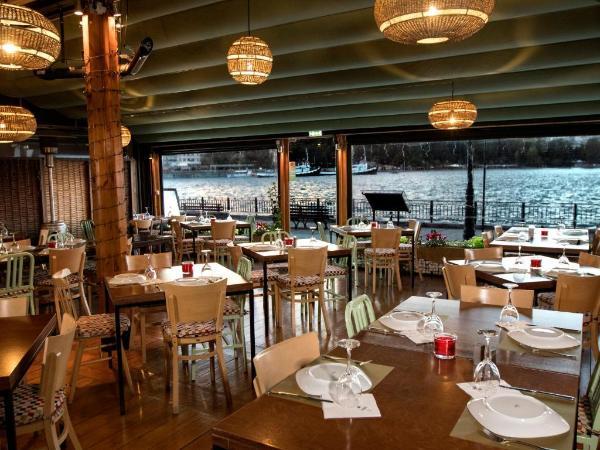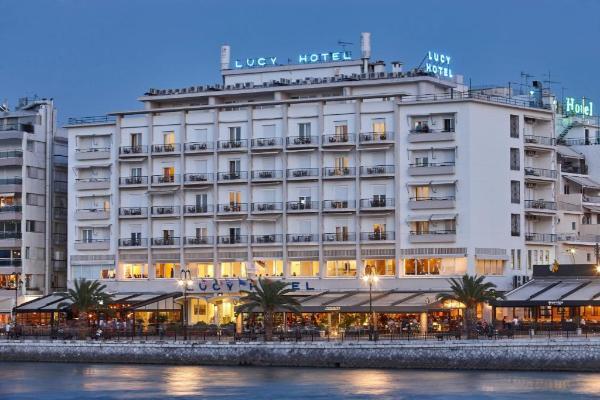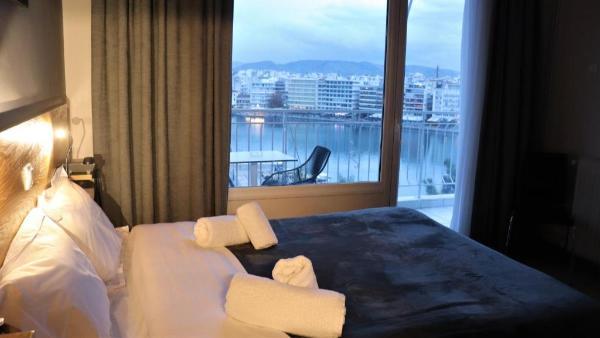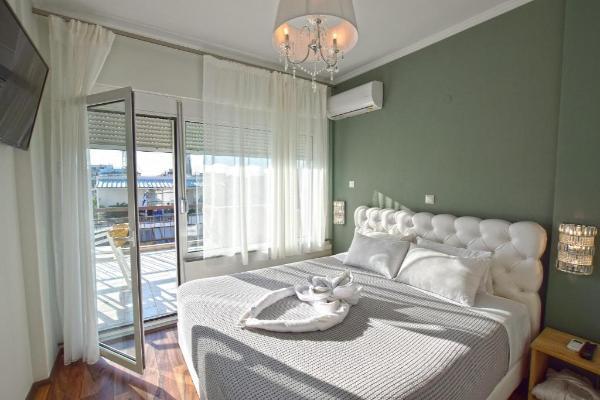Chalkida (or Chalkis) is the capital city of Evia: Greece’s second-largest island. With about 60,000 inhabitants, it comprises nearly a third of the prefecture’s population. It is located on the spot where Evia reaches the closest to the mainland, hence hosting both the connecting bridges and serving as the gateway to the entire island.
Chalkida is far from a popular tourist destination. Even keener-than-the-average travelers who go off the beaten path to explore Evia’s wild beauty tend to omit it, passing through it briefly on their way to the island’s interior. In my opinion, they miss out.
Chalkida happens to be my own beloved hometown, which, after having traveled to about half of the world’s countries, I still regard as my favorite place on Earth. And that’s why I wrote this article: to persuade you, traveler of Greece, to give this charming city its due attention.
Whether you intend to discover Evia broadly or simply seek a brief escapade from the hustle and bustle of Athens, Chalkida city makes for a superb and unique destination. And if you decide to visit, the following are some nice ideas for how to spend your time there pleasantly.
For more on Evia, check here:
Evia Island Travel Blog
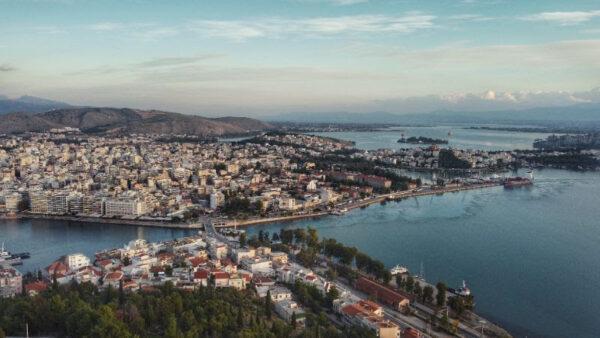
Contents
Affiliation disclosure: By purchasing goods or services via the links contained in this post, I may be earning a small commission from the seller's profit, without you being charged any extra penny. You will be thus greatly helping me to maintain and keep enriching this website. Thanks!
Watch the “crazy waters” shift and the Old Bridge open at Euripus Strait
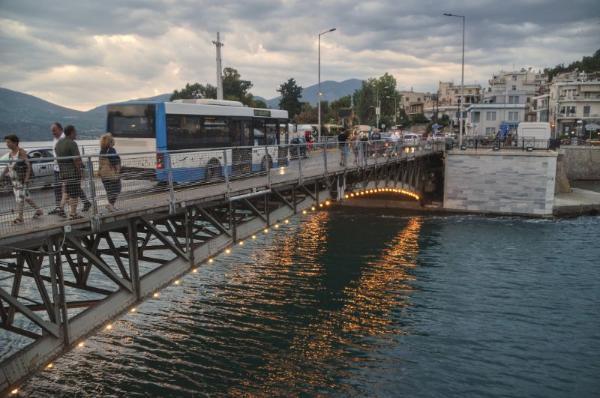
The one thing Chalkida is world-famous for is the peculiar tidal currents that flow interchangeably north-to-south and south-to-north through the Euripus Strait between the island and the mainland. It is this phenomenon that has given the city the nickname crazy waters.
Reversing tidal currents are caused by the moon’s gravity and occur in all straits worldwide, but they are mostly imperceptible by the human senses. It is the distinct geography of Chalkida’s strait—its double-funnel shape among other factors—that make the local currents particularly strong.
The flow peaks at an astounding speed of 12 km per hour, which, for context, is comparable to torrents during floods. For most of the month, the current changes direction about every six hours with a clock’s regularity. But for a few days around the half-moons, it loses its pattern altogether, moving back and forth in chaotic ways.
The 38-meters-wide strait is spanned by an 8-meter-tall bridge, which, constructed in 1963, is the latest of a long succession of bridges dating back to antiquity. The bridge is withdrawn usually once every evening to allow for large vessels to traverse the strait. Given the powerful stream with its notorious vortexes, it requires skillful maneuvering to sail through. It is quite an impressive spectacle to behold. Due to the unpredictability of the currents, the bridge’s opening times are not standard. Estimations are stated on a screen on the spot and live views of the bridge can be seen here.
If you’re now thinking that it’d be great fun to jump from the bridge, you are totally right. But it is unfortunately illegal. However, this detail wouldn’t stop us when we were kids… Free-falling for a short distance, we’d then be engulfed and drifted around by the currents, losing every sense of direction within this dark whirlpool of pressing liquid, for up to half a minute. By the time we’d reach the surface, we could be more than 50 meters away from the bridge, laughing and waving at the coastguards who were always a little too late to stop us.
Stroll along the lively promenades
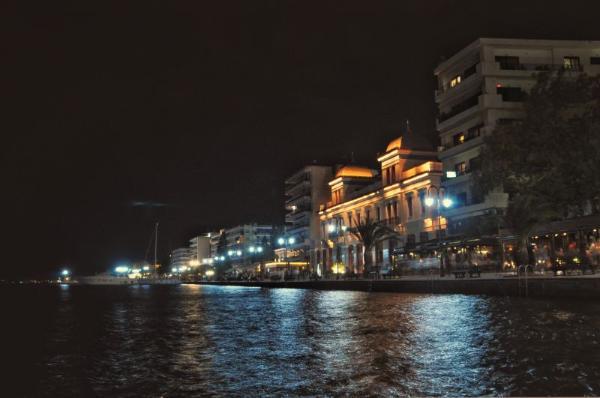
Starting from the bridge, a broad pedestrian road runs along the coast for nearly 1 km, which constitutes Chalkida’s main social hub. On summer weekends, when Athenian day-trippers in addition to the locals flood it, the promenade may be crammed with people to the point of congestion. Its entire length is clustered with consecutive fancy cafes, bars, restaurants, fast food places, and dessert shops whose literally hundreds of tables are constantly occupied by vivid companies. In the narrow bystreets, you find plenty of more (less fancy and expensive), quirky bars and traditional seafood taverns.
A bit further up, behind the church of Saint Nicolaos, there is another pedestrian street called Avanton (which was Homer’s name for Evia’s inhabitants). That is Chalkida’s principal shopping street, featuring a steady flow of folks, buskers, and cute cafeterias.
Marvel at the impressive New Bridge
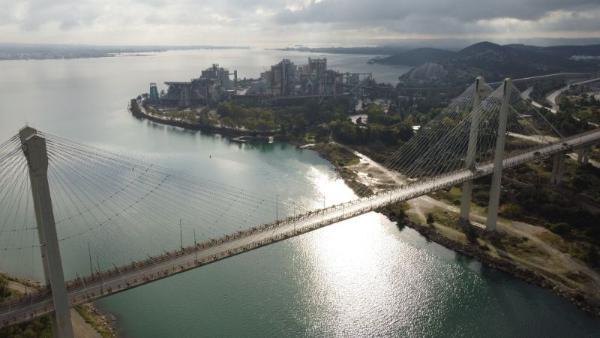
When, at the end of the 20th century, Evia’s logistical needs exceeded the Old Bridge’s capacity, a vitalizing project was undertaken to construct a new, larger bridge to further link the island to the mainland. Its construction was completed in 1993, spanning the second-narrowest stretch of the strait, about a km south of the small bridge.
With a length of nearly 700 meters and a height of 35 meters, it remained Greece’s largest cable bridge until it got surpassed by the bridge of Rio-Antirrio. In combination with the beautiful surrounding landscape and the gigantic, now-abandoned cement factory that lies below, it composes an alluring, picture-worthy scenery.
You may walk across it, along the pedestrian lanes on either side of its deck, or go under it. To do that, just follow the coast south from the Old Bridge for some 3 km. The last part of the walk will take you along a lovely path squeezed between the rocky coast and a lovely pine forest.
Swim and sunbathe at the numerous beaches
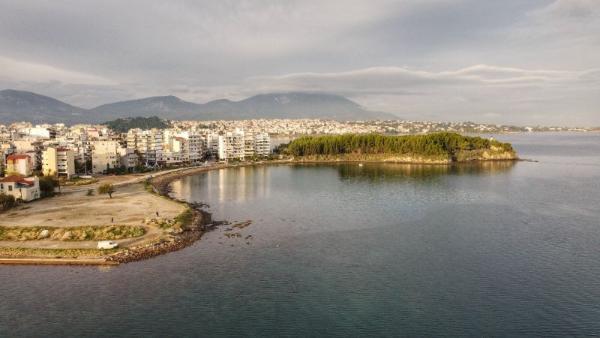
With more than three-quarters of its periphery bordered by the sea, Chalkida has literally tens of different beaches within the city itself. You may choose among several smaller, out-of-the-way ones for some more-or-less private beach time. Or you may prefer one of the more popular beaches to enjoy a drink on a shaded deck chair and perhaps socialize with other bathers. Chalkida has four beaches with food-and-drink serving facilities:
- Asteria, situated right across the main promenade on the mainland side (coordinates: 38.5663, 23.5881); the most popular and sumptuous one.
- Kourenti, along the coast north of the center (coordinates: 38.4716, 23.6024); a mostly family-oriented beach with a seasonal canteen serving drinks and nice food.
- Papathanasiou, further along the coast from the previous one, right east of the lighthouse (coordinates: 38.4743, 23.6057); my personal favorite one, as it is my neighborhood, where some friends of mine maintain the coolest catering establishment in the city that you should definitely check out.
- Sykies, adjacent to the previous one (coordinates: 38.4731, 23.6079); a nice quiet beach with a small cafe up on the road bringing a few tables and deck chairs to the strand, good for children, having an open basketball court and a playground.
Although not technically in Chalkida, 10 km away, near Drosia village, lies the beach of Alykes. This is a long, sandy one with crystal-clear waters and extensive installations where many Chalkideans and Athenians flock on the weekends.
It is also worth paying a visit to Liani Ammos beach, by the northern part of the city proper. As it is very shallow and located beside the main road, it’s not good for swimming. But its broad sandy shoal is frequented by various peculiar birds and interesting to see.
Hike up to the Karababa Castle
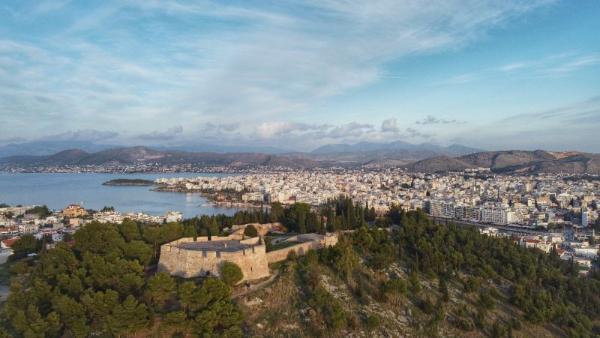
Atop the hill across the Old Bridge, stands an old fortification by the name of Karababa Castle. It was built in 1684, during the Ottoman Era. Only its six-meter-tall wall survives in the present day. It encloses an area of roughly 10 km² wherein you find a chapel, a few abandoned cannons, and a small exhibition. You can climb up to the wall or walk the path around it to wonder at some pretty stunning views of Chalkida and the embracing Euboic Gulf.
Visit the historic mosque and walk the narrow streets of the Turkish old town
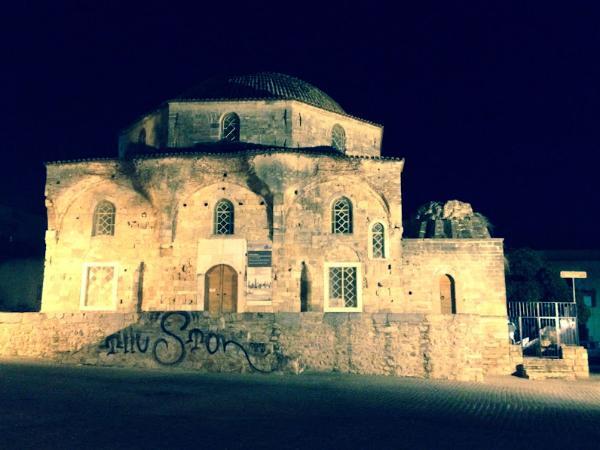
Chalkida was under the control of the Ottoman Empire from 1470 until the last Turkish forces finally departed in 1833, three years after the official foundation of the modern Greek state. The most salient trace of its Turkish past is the Emir Zade Mosque: an elegant structure built sometime in the late 15th century. It is situated a few minutes’ walk from the Old Bridge and is surrounded by a complex of narrow, cobbled streets where you can see samples of residential Ottoman architecture.
Check out the Red House: Chalkida’s most famous building
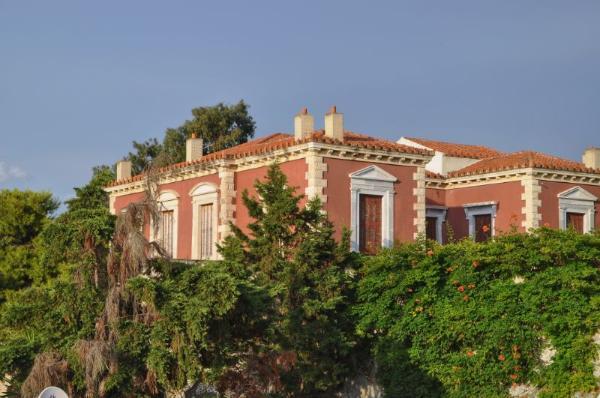
The Red House of Chalkida, so dubbed for an obvious reason, is the city’s most iconic and renowned building. It stands atop a bluff by the northern edge of the promenade and overlooks the sea on three sides.
It was constructed in 1884 in the place of an older Turkish hookah lounge and originally functioned as the private estate of wealthy merchant Vasilios Mallios. It has ever since been employed for various purposes, most notable of which were hosting the exiled King Peter I of Serbia during his kingdom’s occupation by the Central Powers in WWI and housing the Nazi administration during the island’s occupation in WW2. Nowadays, it serves as the headquarters of an educational organization. Unfortunately, the public cannot access its interior save for special occasions like exhibitions.
See the Bad Head Lighthouse and stroll in the surrounding pine forest
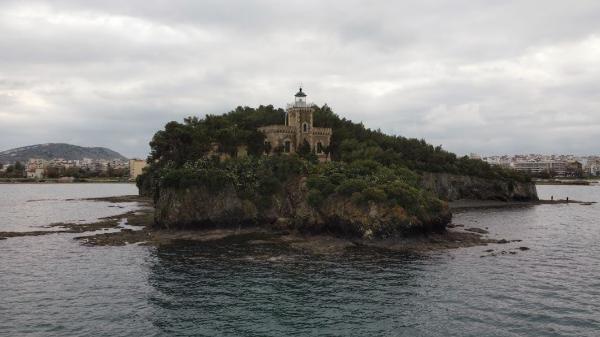
If you take a look at the map of Chalkida, you cannot miss the elongated promontory that sticks out off its northern side. That is called the bad head promontory and on the tip of it stands a picturesque lighthouse overlooking the Northern Euboic Gulf. The rest of the little peninsula is a public park, covered by a graceful pine forest, paths, and viewpoints. When the tide is low, you can also walk around the peninsula, reach below the lighthouse, and enjoy a panoramic view of the gulf and the encompassing mountains.
Visit the Archeological Museums
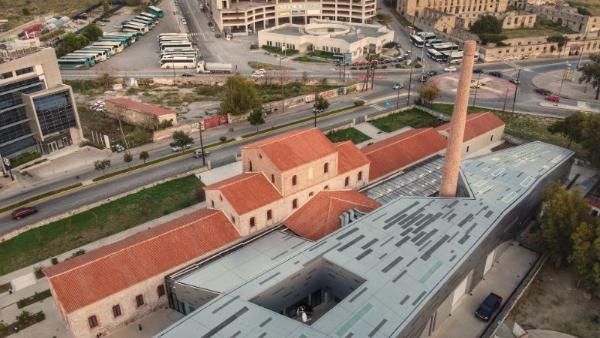
Chalkida has two archeological museums, exhibiting quite an interesting collection of artifacts from antiquity. The old one is located in the city center (coordinates: 38.4629, 23.5940). The new one is housed in a neat, recently-renovated 19th-century factory beside the city’s bus terminal (coordinates: 38.4578, 23.6102).
Check out the medieval church of Saint Paraskevi
This is the oldest church in Chalkida. Parts of it date back to as early as the 5th century AD. Most of the current structure was erected during the period of the Francocracy, between the 13th and 15th centuries. Its facade was reconstructed after collapsing from an earthquake in the mid-19th century. The church is surrounded by a nice park, and a few hidden traditional taverns can be found in the adjacent bystreets.
Take a trip to the nearby medieval Castle of Fylla
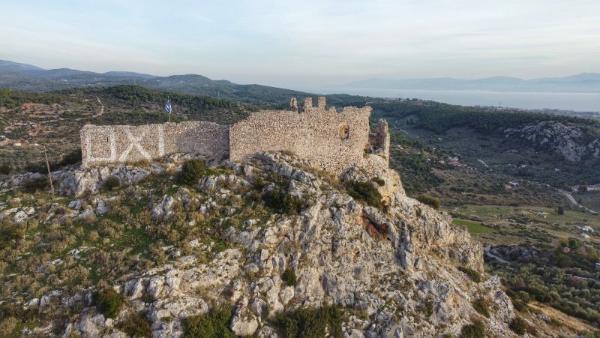
Although not technically located in Chalkida, if you stay here for some time you shouldn’t omit to visit the medieval castle in the nearby village of Fylla. It is a mere 10 km away from the city center, which means you can easily reach it by cycling or even jogging. Dating to the 13th century, it is built atop a conspicuous rock overlooking Chalkida and all its surrounding area. It is characterized by the word ΟΧΙ (no in Greek)—which was the symbol of the Greek Resistance against the Nazi occupation—that still today remains prominently written on the castle’s city-facing wall since that time.
Rent a car and further explore the majestic beauty of Evia Island
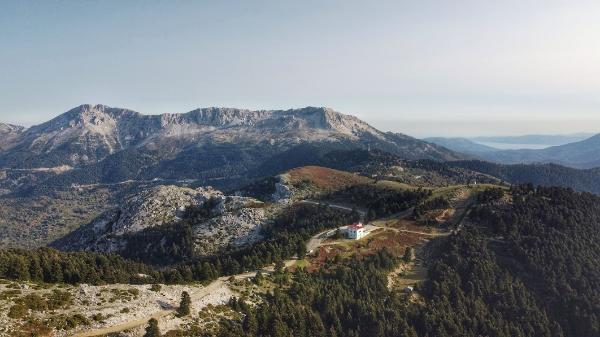
The city of Chalkida is a very fine place to spend a few days. But ultimately, your primary reason to visit it ought to be to broadly discover the fascinating beauty of Evia. From its high mountains to its paradisal beaches and historic towns, this enormous island offers virtually unlimited possibilities for exploration.
Sadly, public transport on Evia is scarce and can only help you to scratch the surface of the island’s secluded beauty. Your best go for properly traveling around the region would be to rent a car. Although a couple of car rental agencies exist in Chalkida, you’d be much better off renting from Athens where choice is greater and hence prices lower. Rentalcars is a site I personally use often to conveniently search across different providers.
Organized tours on Evia Island
How to get to Chalkida from Athens
Chalkida is a bit less than 80 km away from Athens and you can reach it in just about an hour by either driving or public transport.
If you drive yourself, take the E75 motorway, direction Lamia, and follow the signs to Chalkida once you see them. Keep in mind that—very frustratingly so—you will have to pay €4.20 on tolls each way.
Many buses and trains travel from Athens to Chalkida regularly. Buses are slightly more expensive than trains but a bit quicker and more reliable.
Buses depart every 30 to 60 minutes from Liossion Bus Terminal. A one-way ticket costs €7 and a return ticket is discounted to €12.50.
Trains depart approximately every hour from Larissa Station. The ticket costs €6.50.
For more details and alternative ways to reach Evia by ferries, check out this post:
How to get to Evia Island (Euboea) in Greece
Where to stay in Chalkida
Despite its relative popularity among Athenians, Chalkida couldn’t be said to offer a profusion of accommodation options. There are but a handful of hotels in the city. The oldest and best-known ones, that overlook the promenade and the Old Bridge, are:
And these are two more, centrally located but less expensive ones:
You can explore more accommodation options on the map below.
Chalkida Photo Gallery
View (and if you want use) all my photographs from Chalkida.
